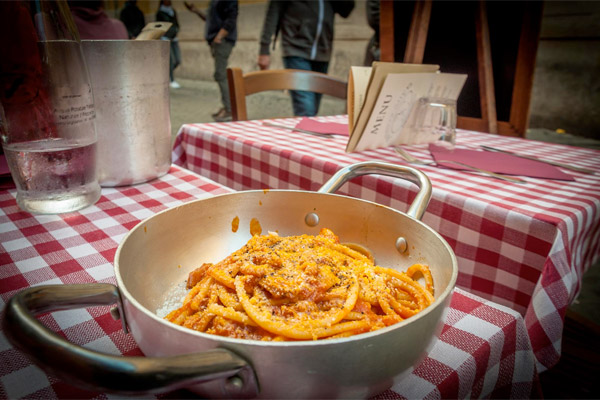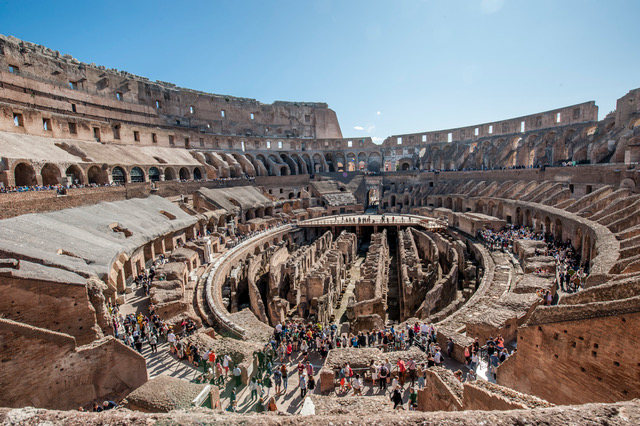When in Rome, Enjoy Typical Roman Cuisine
Italian cuisine is famous worldwide and there is a good reason for this. Italians are passionate about good quality food and Italy is fortunate to have a wonderful larder of fresh ingredients. The provenance of food is paramount, with each region having its own specialties. Several factors influence the ingredients selected for each dish. Seasonality, location, freshness and regional traditions all have an impact.
Starters and First Courses
Usually listed as ‘Antipasti’ and ‘Primi’ on a menu. Here are some traditional dishes you will find on a Roman menu:
Antipasti
Supplì – Coated in breadcrumbs then deep-fried, these circular or croquette-shaped starters are made with rice and filled with mozzarella, a ‘ragu’ (meat sauce), and tomato-based sauce.
Bruschetta – Grilled bread brushed with garlic then topped with olive oil, salt, and chopped tomatoes and basil. Other variations can include artichokes, truffles, or mushrooms.
Primo (first course)
A primo could be a pasta, risotto, or a soup dish. Pasta is generally eaten as a first course followed by a main (‘secondo’).
Pasta comes in many variations and the type of sauce to go with each pasta dish will depend on the type and shape of the pasta. Pecorino Romano cheese is the one ingredient that you will definitely taste in many typical Roman dishes.
Typical Roman pasta dishes
Cacio e Pepe – A delicious pasta dish with Pecorino Romano cheese, black pepper, a splash of olive oil, and a touch of the pasta cooking water which creates a creamy sauce.
Spaghetti alla Carbonara – A well-known dish that celebrates #carbonaraday on April 6th. Spaghetti is mixed with eggs, guanciale (cured meat from pork), pepper, and grated Pecorino Romano cheese.
Bucatini all’Amatriciana – The word ‘bucatini’ originates from the Italian word ‘buco’ meaning ‘hole’. This long thin pasta is like spaghetti with a hole through the middle. It is topped with a tomato-based sauce, guanciale, and grated Pecorino Romano cheese.
Main Meal Options
Typical Roman dishes include:
Scaloppine alla Romana – Veal sauteed with fresh baby artichokes.
Saltimbocca alla Romana – Roman-style veal cooked with ham (prosciutto) and sage.
Trippa alla Romana – Tripe cooked with a tomato-based sauce and mint, topped with Pecorino Romano cheese.
Side Dishes
Tasty, fresh, and seasonal vegetables accompany main dishes. Artichokes are a popular option and are served in several restaurants across the city. Traditional dishes include Carciofi alla Romana, whole artichokes cooked with garlic, herbs, and olive oil or Carciofi alla Giudia (Jewish style, deep-fried artichokes).
Fiori di Zucca another delicious option, zucchini flowers filled with mozzarella cheese and anchovies then covered in batter and deep-fried.
Pizza
If it’s pizza you’re after, you’ll be spoilt for choice of pizzerias. With so many fresh ingredients, you can have nearly anything on a Roman pizza which generally has a thin and crispy base. Either sit in and enjoy a pizza or savor a pizza al taglio (pizza by the slice) to take away and try a few different toppings.
Desserts
If you have any space left after a starter and a main, there are several sweet treat options to select from. Ice cream and sorbets in a multitude of flavors are always a popular choice. If you need a stroll to digest your food, wander along to one of the city’s many ice-cream parlors. Good luck choosing just one or two flavors. The sheer choice of ice cream flavors is something else!
When in Rome though, the tiramisu, a dessert made with ladyfinger biscuits soaked in coffee and a creamy filling, is a must-try. Famous worldwide, the tiramisu also has its own annual day of celebration on March 21st.
Post Dinner Drinks
Finish your meal with an Italian liquor or ‘digestivo’. Amaro and Limoncello are two of the most popular options, however, there are many after-dinner drinks available to sample.
If you love Italian food and would like to find out more about typical Roman cuisine, we recommend one of our food tours. Our expert food guides will take you to the best places to sample the finest in traditional Roman cuisine.






























 most out of your visit. This week we are wandering through the charming streets of Trastevere, one of Rome’s most interesting districts.
most out of your visit. This week we are wandering through the charming streets of Trastevere, one of Rome’s most interesting districts. 









 strict in Rome
strict in Rome






 ntrale of its own inside Termini Station. Although this market does not exactly convey the traditional Italian market experience, it does bring together some of the region’s best food producers. That is why we chose to explore the new Mercato Central Roma for Enjoy Rome’s first Mercato Monday.
ntrale of its own inside Termini Station. Although this market does not exactly convey the traditional Italian market experience, it does bring together some of the region’s best food producers. That is why we chose to explore the new Mercato Central Roma for Enjoy Rome’s first Mercato Monday.









